A better way to find Park City School District Covid Numbers
The good news is that the Park City School District is publishing the number of students in schools with Covid-19. The bad news is that it is almost impossible to find.
We’ve tried to help people on Next Door and Facebook find the numbers but it isn’t easy. You have to navigate to the district web page, find a link, find another link, go into a PDF, then enter Google Docs.
So, we’ve found an easy way to post them here on the Park Rag. If you are on a laptop/desktop, you can click here:
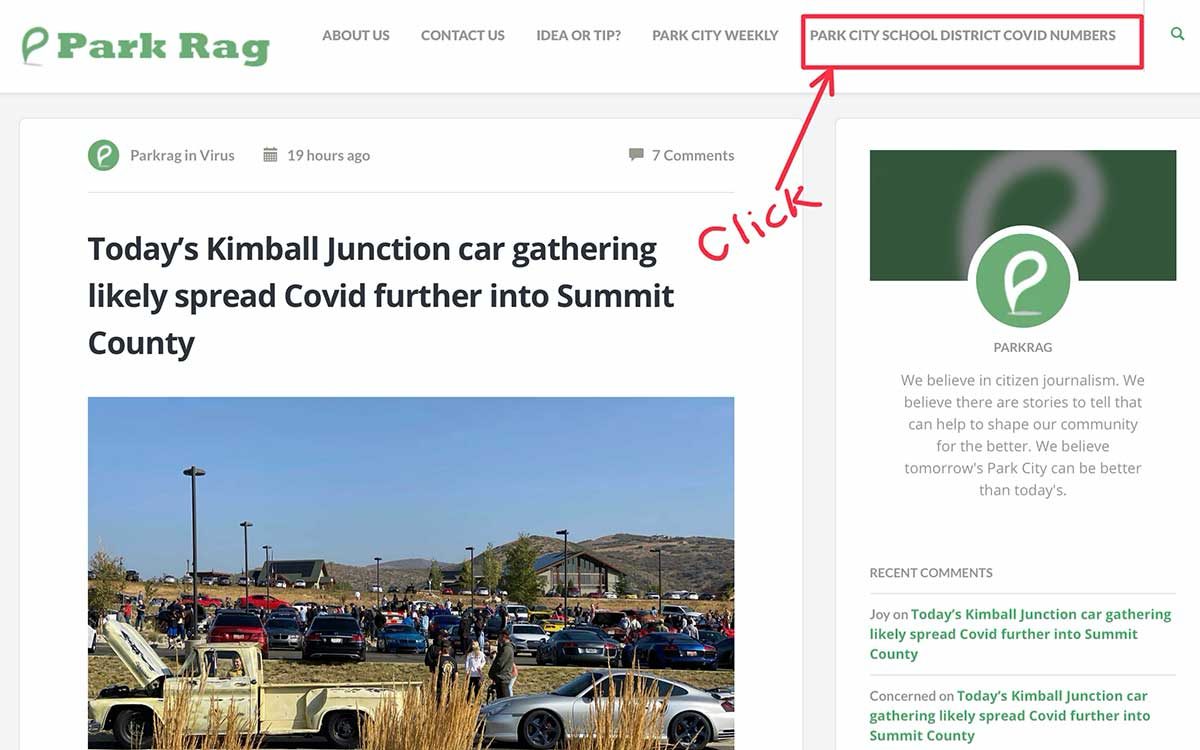
On a mobile phone, click the “pancake” menu in the upper right and then click on the menu item “Park City School District Covid Numbers.”
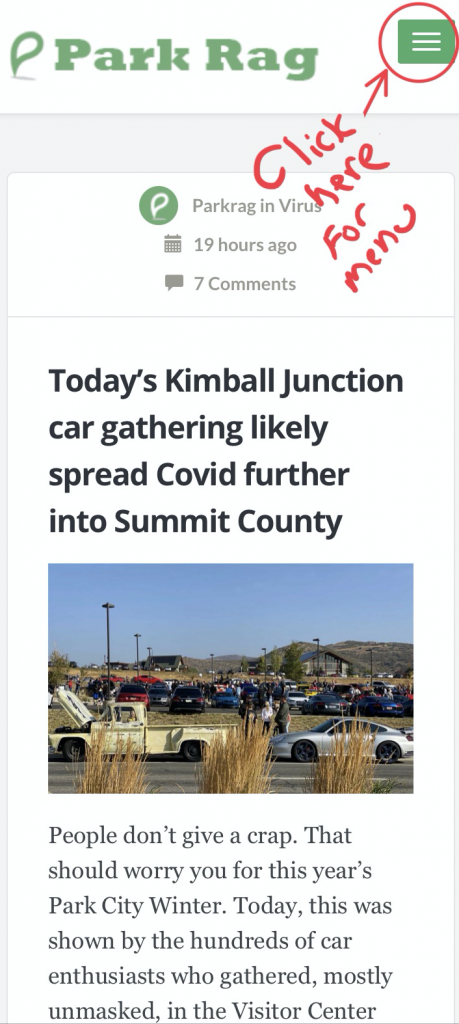
We can’t control the content, but hopefully it’s an easier way to find information. It appears the school district updates the info on Friday.
You can click on the menu above or here for this week’s numbers.
Update: The School District’s spreadsheet was updated again today (9/21). Looks like the two previous COVID-cases have dropped off (the date where they can return to school passed). There appears to be another case (likely the third case in our schools) that was reported today at PCHS.
Today’s Kimball Junction car gathering likely spread Covid further into Summit County
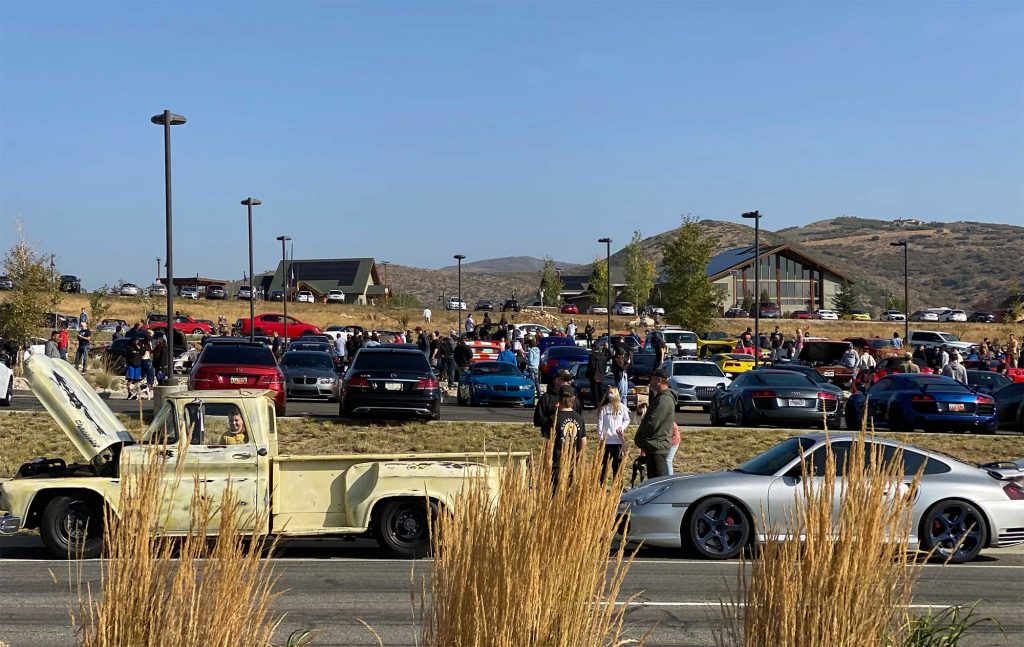
People don’t give a crap. That should worry you for this year’s Park City Winter. Today, this was shown by the hundreds of car enthusiasts who gathered, mostly unmasked, in the Visitor Center Parking Lot in Kimball Junction.
As they stood in groups and then moved from car to car, you could see the virus spreading with them. Keep in mind that it is illegal to gather in groups of 50 or more. There were clearly at least two or three times this number at this gathering.
The only positive for Summit County residents is that most of these people were probably from the valley. You know, the same places that have accounted for about 2,100 new coronavirus cases over the past three days. So, hopefully, they came, some probably got infected, and they left.
God help us if they spent time or money at any business here. Sorry Hugo Coffee, you were probably too close to avoid the infected masses.
Outside of today’s impacts, it just bodes horribly for the winter. While car enthusiasts are passionate, they are few. Skiers and boarders from the valley are both passionate and plentiful. If the state reports more Covid-19 cases than New York City during a two-day stretch, and people are still willing to gather in the numbers seen this morning, I wonder what stupidity the ski season will bring.
Some may say we need to levy a fine on the owner of the parking lot where this event occurred. The owner, in this case, would be Summit County. That’s funny. However, the county should pass an emergency ordinance stopping car events in any lots that it owns — punishable by fines. If they don’t, they are complicit going forward — and that’s not the way our Health Department and government have operated since this began. You wish it wouldn’t have to be this way because previous car events seemed like people were having fun. Those were different times, though.
I really can’t believe that a few hundred people would want to gather in close proximity to others, given recent events — even if it was outside. Then again, I’ve never understood the thought process of a lot of people.
So far, since March, we have done pretty well against the coronavirus in Summit County. Except for the lodge party, our daily coronavirus counts are typically in the low, single digits. That’s likely not true for long.
Winter is coming.
Will you take a bus to ski this winter?
As we approach Labor Day, many of our thoughts turn toward skiing. Usually, Parkites make ski-lesson and season pass decisions around the end-of-summer holiday. This year it is more complicated.
If you are an Epic Pass holder from last year, you’d probably get about 20% off on your pass this year due to Vail’s earlier-than-planned closing. Similar things are happening with the Ikon Pass and Deer Valley season passes. However, then you have to consider Vail’s reservation system. What’s that going to look like? Given the backlash to the reservation system, Deer Valley will likely get more visitors than before. That’s almost impossible to fathom, given the what has happened at DV due to Ikoners from SLC.
Yet, I’ve been thinking more and more about the buses. It’s been years since I have parked in a ski resort parking lot. I always take the bus from Kimball Junction (or Ecker) to Deer Valley, PCMR, or Canyons. However, with Covid-19, I can’t imagine there are many worse places than sitting in an enclosed bus with ten other riders (maybe forty other riders at times).
From KJ to Canyons is ten minutes on the White Electric #10 Bus. If I believe the science, then I have little to worry about even if everyone else on that bus is infected, because I am only around them, in an enclosed box, for ten minutes (not fifteen). So, for me, that argues going with an Epic Pass.
If I rode to Deer Valley on the White Electric bus, it would be at least 30 minutes and a transfer to an in-town option that goes to DV (another 10 minutes). Those in town buses to DV are often REALLY packed, but maybe not this year over the same virus concerns. Yet, I’d be spending forty minutes on buses with little airflow. Then, I’d be hoping that the busses to DV won’t be packed.
Do I wager $2500 on a Deer Valley ski pass to the hopes that the buses will be OK? Or do I Wager $700 on an Epic Pass that requires reservations, but the bus ride is shorter? Oh, and will Deer Valley do the reservation thing, too? Perhaps they are just slower than Vail and so they haven’t announced it.
So, I’ll likely do the Epic Pass. It’s funny how committing to public transport, where you can, completely influences decisions. I suppose I could drive to Deer Valley. However, I think parking at any resort this winter is going to be a total nightmare.
Hideout Utah is a hell-hole that no one should be associated with
Hideout, the town on the banks of the Jordanelle Reservoir, on the Wasatch County side of the map, is attempting to annex parts of Summit County near the Richardson Flat parking lot. Summit County is fighting the effort in court.
Basically, the town of Hideout didn’t plan adequately for services for its residents and now it wants to expand into Summit County. Meanwhile, Mitt Romney’s kid, Josh, and Nate Brockbank want to capitalize on that and build a mixed-use facility around Richardson Flat. Why? Because they want to make money.
The downside to Park City and Summit County is that we won’t be able to exercise planning over any of it. It will only make traffic worse. The shit-show that can be Wasatch County will come within a stone’s throw of Quinn’s Junction. Don’t get me wrong, Wasatch County will still be a problem for Park City in the long run, but this will exacerbate it and accelerate it.
The reason that a city in another county can annex pieces of land in a different county is due to the legislature’s incompetence. It doesn’t make any sense. The Utah Legislature was lobbied to do this a few years ago and the brilliant minds in SLC allowed this. The Legislature may repeal it due to citizen pressure but maybe not in time.
Perhaps Hideout will rule the day and Romney, et. al will get rich(er).
Perhaps not.
I think too often we look to the government for solutions. Maybe the government will find one. Great.
However, if we the people take things into our own hands we can influence things. If real estate agents put the community above their commissions they can influence buying decisions. Perhaps, you don’t show houses in Hideout. It’s your choice.
If you, as an average person, are asked about living in Hideout, you can tell them that everyone hates Hideout. You can tell them that buying a property there is the worst decision that they could ever make. If they live there, they will be a pariah.
If you are out at a bar and someone tells you that they live in Hideout, you can respond, “I’m sorry” and walk away.
To those that have a property in Hideout and say, “This is not fair. It’s not our fault.” I respond with a simple statement:
Control your f****ing government.
There has not been an increase in students at Park City schools this year
Coming into this year’s school year, rumors were rampant about the number of new kids coming to Park City. The narrative was that people were fleeing their Coronavirus-infused hellholes to come to idyllic Park City – and they were bringing their kids with them.
At one point I heard there were going to be 700 additional students in our district. I could have believed it. The only problem is that it wasn’t true. Maybe the parents came here for the summer and are planning to stay for the winter, but it looks like they left the kids home with their nannies.
On Thursday, during Leslie Thatcher‘s Local News Hour on KPCW, Ms. Thatcher asked Park City School District Business Administrator Todd Hauber about the number of students the district is seeing so far. Mr. Hauber replied that official numbers would come out in October, but the district did an unofficial headcount (on Tuesday) like they do every year. According to Mr. Hauber, “There were around 3600 in-person students and around 835 online learners” as part of the count. He noted that the total is between 4400-4500 students and is usually about 95% to 96% of the number of students that are presented as part of the official count in October. He said the numbers are in line with what they were expecting.
I’ll point out that last year‘s official Park City enrollment was 4,757. If the headcount turns out to be 95% of the final numbers, our student population this year will be around 4,735 — down a bit from last year. That would be similar to last year, where we saw a 0.5% decrease in students.
In this Coronavirus-crazed world who know what could eventually happen with the numbers, but as of today, it appears the fears of our schools being jammed due to new students were unfounded.
Park City bus ridership has not returned to pre-covid levels yet
One of the signs that Park City “is back” will be bus ridership. We aren’t there yet and are barely above the complete-COVID days of April. For the last 30 days, we are averaging about 1.8 people on each bus. Around 8 AM and 5 PM we may get up to 5-6 people per bus, which makes sense with people going to and from work.
However, keep in mind, we need about 9 people per diesel bus to make it more environmentally friendly than driving a car.
At some point, we may need to discuss options other than large buses. Should we be running those yellow vans that run around Kimball instead of the large buses until ski season (if it happens)?
As of now, people either don’t want to ride the buses or don’t need to. We’ll keep you updated on this as changes happen.
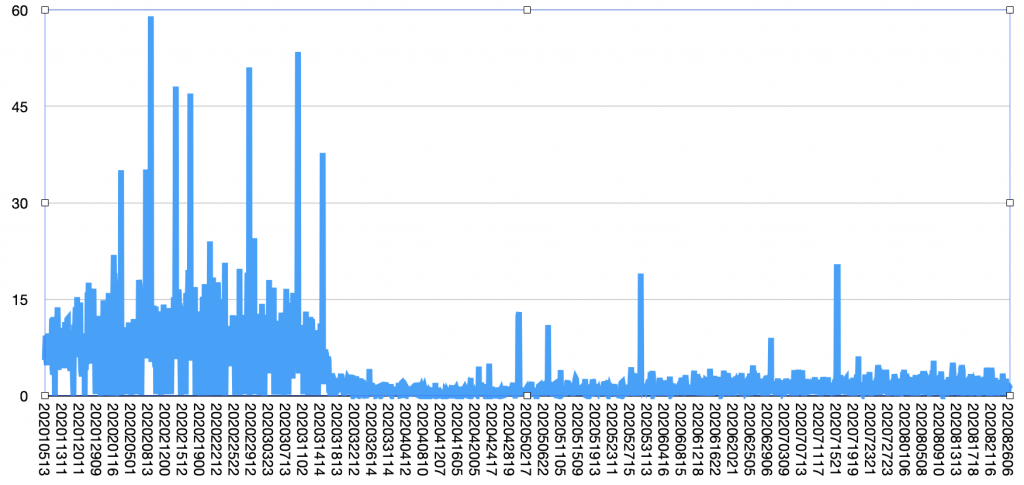
Summit County should charge non-residents for trails use
We have been dancing around the issues for years. Summit County residents fund our trails through property taxes. Most trails are managed through Basin Rec.
Tonight, I sat through a painful Snyderville Basin Planning Commission discussion about whether Basin Rec should be able to add parking stalls near Pheasant Lane near Creekside on the north-side of I-80.
Basin Rec argued that the users of the parking spaces used our trails and therefore, we needed additional parking because there weren’t enough. People against the effort argued that the people who wanted parking don’t live here.
Somehow, our esteemed Planning Commissioners voted for adding parking stalls, even though they acknowledged 80% of the people using them were from Salt Lake.
What Basin Rec doesn’t realize, but they will on the next bond vote, is that if I can’t park at a trailhead I paid for, then they will not get money the next time. My trail dollars do not fund Salt Lake citizens. They fund Summit County.
It’s that simple.
It’s time for enforcement at our trailheads. The people who live in Summit County already support them through tax dollars. If you don’t live here, you should support their maintenance.
It’s no different from a campsite. You camp, you enjoy, you pay. It’s not much money , but you support the area you are impacting.
We need to grow up and make adult decisions.
Now is not the time to change the rules on the Kimball Junction Tech Park
The two most powerful warriors are patience and time.
LEO TOLSTOY, WAR AND PEACE
Should we allow the Tech Park by the Skullcandy building to be turned into a hotel, 900 apartments, 200 more rental units, and retail? That is the question in front of the Snyderville Basin Planning Commission. That question will ultimately go to the Summit County Council.
The groups that support the Dakota Pacific developer and their desire for change cite the need for an affordable housing development that is transit-oriented and walkable in Kimball Junction. Critics of changing the Tech Park rules to allow increased development say that we fought hard for a tech park that could diversify our economy with higher-paying jobs and support the community as global warming encroaches on the winter resorts.
It’s been interesting watching the politics of it all. On the for-change side, you have the Summit County staff. According to the Park Record, “Unusually, county staffers also indicated support for the project, among them Regional Transportation Planning Director Caroline Rodriguez, Economic and Housing Director Jeff Jones and planner Kirsten Whetstone.” HMM. Its interesting that they are taking sides, but that’s a story for a another day.
Then you also have an individual, Tyler Quinn Smith from Jeremy Ranch, who has worked in land-use development and espouses “sustainable neighborhoods” writing a Park Record editorial and Facebook post that calls critics ill-informed and the “old-guard.” He also says, “Yet we are far outnumbered by older, wealthier homeowners who judge this project from their personal car windshield driving 60 mph down SR-224.”
On the against-change side, I guess you have that “old guard” in Sally Cousins-Elliot and Bob Richer who were both County Commission Members that approved the Tech Park in 2008. Elliot, commented in an email, “As the ski industry suffers the effects of climate change, we need to look to the future of our economic health. This is the ONLY location where we can encourage high tech diversity in our area with high end jobs. 1100 rental units and a 130 room hotel at this location is the wrong place, wrong time, wrong idea.”
Richer, in a KPCW interview, argued that the affordable units at the development weren’t really affordable with some that could cost $2,300 a month. He also stated that traffic would be worse under the Dakota Pacific proposal versus the slow build-out of the Tech Center. Finally, he said that Dakota Pacific came into this with eyes-wide-open.
I look at this somewhat differently. My day job is in tech, and I don’t know for certain if a tech park will work in Kimball Junction. Like most things, I believe there are few good ideas or bad ideas, just execution. To date, Boyer wasn’t successful. However, I’ve heard second-hand that some executives at the University of Utah Research Park didn’t even know there was a Tech Park in Park City. So, maybe Boyer was just crappy at marketing a Tech Center. That wouldn’t surprise me.
In my mind, Summit County has an ace in the hole with the Tech Park. The way it has played out has afforded us time. Time buys perspective and better knowledge. Who knows how this COVID thing plays out. Is it done in a few months or does it stretch for years? What does Park City and the Snyderville Basin look like afterward?
What does development in Wasatch County County look like when it gets going — including Mayflower. How many additional residences will there be on Park City’s doorsteps? 8,000? 20,000? More?
Closer to home, and already approved, we have Silver Creek Village, Park City Heights, the Canyons build-out, and Discovery (by Summit Park). Have you been out to Silver Creek Village lately? That’s the development with 1200 units out by Home Depot. If you haven’t you should take a look. I did, and I’m not sure what to make of it. I have no idea how that development will ultimately work, function, or tie into transit. I’m not sure of its broader impacts on the framework of the Basin and Park City.
The same can be said of the impacts from PC Heights, Discovery, Canyons, and the Wasatch County developments. What are the needs of the Snyderville Basin once the approved developments around us start to take form and begin to function? Do we need another school? Do we need parks? Do we need baseball fields? Do we need recreation facilities? Do we need a Tech Park, Do we need another hotel? Do we need apartments?
I don’t know.
We the people of Summit County have something very valuable in our possession with control over the use of the Tech Park. We have a piece of land that is defacto open-space that can become anything based upon the rules that we set. Some day it will be developed into something. It may become a Tech Park. It may become apartments. It may become forever open-space. It may become something we never thought we needed in 2020.
I would argue that if we allow Dakota Pacific to develop this right now, we are giving it away. We are trading our future for… I don’t know what… making the developer money?
I have not seen anything compelling enough from the developer to change the rules on this jewel. It’s just not worth it.
Tolstoy said the two most powerful warriors are patience and time. I believe if we have the patience, we will be provided with the time to make an optimal decision for the long-run of the Snyderville Basin and Park City. By waiting and turning down Dakota Pacific’s offer, I believe we will ultimately find a better use of the land.
Tomorrow’s the final day to enroll for remote-learning
Smoke ’em if you got ’em.
Tomorrow’s the “final” day to enroll in remote learning in the Park City School District. If your child will be choosing this option, you need to complete the Remote Learning Form. More information on remote learning at the PCSD can be found here.
If you have been on the fence, now is the time to decide. The school district needs in-person/remote class numbers to plan appropriately. I’m frankly amazed that a week and a half is enough to adequately plan. So, please keep our community and teachers in mind and make your decision on time.
That said, the school district isn’t doing itself any favors on this topic. I’m often amazed at how poor communication can be from our schools on some topics, especially when their business is education. Just for fun, go to the Park City School District Home Page and let me know if can easily find the Remote Learning Form?
Maybe I missed it and they are blitzing parents with emails on the subject. Could be.
Maybe I’m blind and there is a gigantic button at the top of the school district website. If so, I didn’t see it.
Maybe there have been multiple posts on the district’s Facebook page helping them register for remote learning. Could be but all I see as of 1:30 PM on Thursday is something about graduation from two days ago.
Regardless, if they make it hard to register for remote learning, the district is going to get results later than is optimal. So, don’t be surprised if you can actually register for remote learning until August 19th.
Good luck with that teachers.
UPDATE (8/7/2020): Looks like the school district added links to the remote form on their Home Page. That should be helpful.
Israel’s school reopening failure shows Park City Schools it’s all about how you execute
If you are teacher who will be teaching this fall…
If you are an administrator who will be running schools…
If you are a leader in the Park City School District…
There is one article you should read today in the New York Times. “When Covid Subsided, Israel Reopened Its Schools. It Didn’t Go Well.“
I know there is a lot of debate among teachers, parents, and others about reopening schools in Park City. Two weeks from now, though, it is happening.
Here’s what happened in Jerusalem according to the Times, “Confident it had beaten the coronavirus and desperate to reboot a devastated economy, the Israeli government invited the entire student body back in late May. Within days, infections were reported at a Jerusalem high school, which quickly mushroomed into the largest outbreak in a single school in Israel, possibly the world. The virus rippled out to the students’ homes and then to other schools and neighborhoods, ultimately infecting hundreds of students, teachers and relatives.”
The problem was that schools caved to pressure from parents. “Then a heat wave hit. Parents complained that it was inhumane to make children wear masks in steaming classrooms where open windows nullified the air conditioning. In response, the government exempted everyone from wearing masks for four days, and schools shut the windows. That decision proved disastrous, experts say.”
Instead of closing schools, they told students they could take off their masks because it was so hot. They closed the windows. That removed the benefits of ventilation. They made bad decisions. They didn’t execute.
One bad decision, driven by parents and accepted by schools caused a catastrophe. In Park City … parents, students, teachers, administrators, and the district personnel will all have the chance, many times a day, to make good decisions or bad decisions. Those decisions could keep us on the path to making it through the year or careen us into the ditch. This can’t be emphasized enough. We all need to work together to give education a chance, but any single one of us can ruin it.
So what happened in Israel? Two students in one high school tested positive. Then the whole school was quarantined and everyone was tested. Sixty percent of those infected were asymptomatic. “Teachers, some of whom had been teaching multiple classes, suffered the most and a few were hospitalized, the principal said.
This is what happened across the country next, “Seeking to contain the contagion, the Education Ministry vowed to shut any school with even one Covid-19 case. It ultimately closed more than 240 schools and quarantined more than 22,520 teachers and students. When the school year ended in late June, the ministry said, 977 pupils and teachers had contracted Covid-19.”
Some people in Park City would argue, “can you even open schools safely?” It’s a fair question, but that debate has passed. Now it’s all about the execution. What’s at stake are lives and in the broader sense the Park City winter season. If that goes away, much of the best parts of Park City will go with it and may not come back.
Every day, every student, parent, teacher, and administrator has a part in a grand game. Can we generally do the right thing? Can we make good decisions? Can we have discipline?
If not, Israel’s experiment tells us what it will look like.
And if we look like this school in Georgia on its opening day, we know where we are headed.
